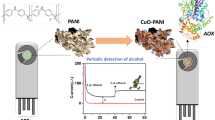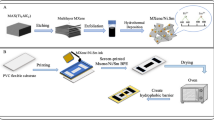Abstract
This study reports a micromachined parylene-C-coated integrated electrode (IDE) sensor fabricated on a polyimide film. Glucose and uric acid within the human sweat concentration range were tested using hydrothermally grown ZnO nanoparticles (NPs) immobilized on the IDE regions of sensors and modified with urate oxidase and glucose oxidase enzymes. Four important sensing parameters, including capacitance, impedance, resistance, and phase, were simultaneously investigated during the dynamic test. The sensor fabrication and characterization of ZnO NPs and ZnO NP formed sensing film were described in detail. The experimental results show that the amount of capacitance change and phase change vs. the concentration variation of glucose and uric acid exhibits an excellent linear regression relationship. On the other hand, the amount of impedance change vs. concentration variation of glucose and uric acid exhibits a power regression relationship. Sensitivities of uric acid and glucose detection based on capacitance changes were 0.1131 pF/µM and 0.7875 pF/µM, respectively. Limits of detection of uric acid and glucose were 1.23 µM and 0.311 µM, respectively. Thus, the developed sensor can be applied to wearable devices for the quantitative analysis of sweat composition in the future.
Graphical abstract













Similar content being viewed by others

References
Bariya M, Nyein HYY, Javey A (2018) Wearable sweat sensors. Nat Electron 1(3):160–171
Helbostad JL, Vereijken B, Becker C, Todd C, Taraldsen K, Pijnappels M, Mellone S (2017) Mobile health applications to promote active and healthy ageing. Sensors 17(3):622
Kim J, Campbell AS, de Ávila BEF, Wang J (2019) Wearable biosensors for healthcare monitoring. Nat Biotechnol 37(4):389–406
Windmiller JR, Wang J (2013) Wearable electrochemical sensors and biosensors: a review. Electroanalysis 25(1):29–46
Ghaffari R, Rogers JA, Ray TR (2021) Recent progress, challenges, and opportunities for wearable biochemical sensors for sweat analysis. Sens Actuators B 332:129447
Bandodkar AJ, Wang J (2014) Non-invasive wearable electrochemical sensors: a review. Trends Biotechnol 32(7):363–371
Yang Y, Gao W (2019) Wearable and flexible electronics for continuous molecular monitoring. Chem Soc Rev 48(6):1465–1491
Bruen D, Delaney C, Florea L, Diamond D (2017) Glucose sensing for diabetes monitoring: recent developments. Sensors 17(8):1866
Sharma A, Mahajan P, Singh A, Arya S (2022) Detection of physiological markers Via Wearable devices for Human Healthcare. ECS Trans 107(1):20265
dos Santos CC, Lucena GN, Pinto GC, Júnior MJ, Marques RF (2021) Advances and current challenges in non-invasive wearable sensors and wearable biosensors—A mini‐review. Med Devices Sens 4(1):e10130
Polat EO, Cetin MM, Tabak AF, Bilget Güven E, Uysal BÖ, Arsan T, Gül SB (2022) Transducer technologies for biosensors and their wearable applications. Biosensors 12(6):385
Killard AJ (2017) Disposable sensors. Curr Opin Electrochem 3(1):57–62
Chung M, Fortunato G, Radacsi N (2019) Wearable flexible sweat sensors for healthcare monitoring: a review. J Royal Soc Interface 16(159):20190217
Qiao Y, Qiao L, Chen Z, Liu B, Gao L, Zhang L (2022) Wearable sensor for continuous sweat biomarker monitoring. Chemosensors 10(7):273
Chertoff J, Chisum M, Garcia B, Lascano J (2015) Lactate kinetics in sepsis and septic shock: a review of the literature and rationale for further research. J Intensive care 3(1):1–4
Faria EW, Parker DL, Faria IE (2005) The science of cycling. Sports Med 35(4):285–312
Pérez FP (2018) Uric acid renal lithiasis: new concepts. Uric acid in chronic kidney disease, vol 192. Karger Publishers, Basel, pp 116–124
Vernerová A, Krčmová LK, Melichar B, Švec F (2021) Non-invasive determination of uric acid in human saliva in the diagnosis of serious disorders. Clin Chem Lab Med (CCLM) 59(5):797–812
Hediger MA, Johnson RJ, Miyazaki H, Endou H (2005) Molecular physiology of urate transport. Physiology 20(2):125–133
Huang M, Wang Y, Song M, Chen F (2022) Bimetallic CuCo prussian blue analogue nanocubes induced chemiluminescence of luminol under alkaline solution for uric acid detection in human serum. Microchem J 181:107667
Min J, Sempionatto JR, Teymourian H, Wang J, Gao W (2021) Wearable electrochemical biosensors in North America. Biosens Bioelectron 172:112750
Hunt LM, Arar NH (2001) An analytical framework for contrasting patient and provider views of the process of chronic disease management. Med Anthropol Q 15(3):347–367
Ginsberg BH (1992) An overview of minimally invasive technologies. Clin Chem 38(9):1596–1600
Mandpe P, Prabhakar B, Gupta H, Shende P (2020) Glucose oxidase-based biosensor for glucose detection from biological fluids. Sens Rev 40:497
Mahato K, Maurya PK, Chandra P (2018) Fundamentals and commercial aspects of nanobiosensors in point-of-care clinical diagnostics. 3 Biotech 8(3):1–14
Tamilselvi M, Raj P, Vidule RR, Ankanagari S (2022) Commercial non-invasive glucose Sensor devices for Monitoring Diabetes. Advanced Bioscience and Biosystems for detection and management of diabetes. Springer International Publishing, Cham, pp 273–292
Harman-Boehm I, Gal A, Raykhman AM, Naidis E, Mayzel Y (2010) Noninvasive glucose monitoring: increasing accuracy by combination of multi-technology and multi-sensors. J Diabetes Sci Technol 4(3):583–595
Liu Y, Lv J, Yang L, Cui Y (2022) Electrochemical Uric Acid sensors: fundamentals and Commercial Status. J Electrochem Soc 169(12):127520
Paraskos J, Berke Z, Cook J, Miner JN, Braddock M, Platt A, Hughes G (2016) An analytical comparison between point-of-care uric acid testing meters. Expert Rev Mol Diagn 16(3):373–382
Kare O, Das SP, Chaudhury D, K., Das S (2021) Hand-drawn electrode based disposable paper chip for artificial sweat analysis using impedance spectroscopy. Biomed Microdevices 23(4):1–12
Ferri S, Kojima K, Sode K (2011) Review of glucose oxidases and glucose dehydrogenases: a bird’s eye view of glucose sensing enzymes. J Diabetes Sci Technol 5(5):1068–1076
Adam RE, Pozina G, Willander M, Nur O (2018) Synthesis of ZnO nanoparticles by co-precipitation method for solar driven photodegradation of Congo red dye at different pH. Photonics and Nanostructures-Fundamentals and Applications 32:11–18
Ma Z, Tang Z, Wang E, Andersson MR, Inganäs O, Zhang F (2012) Influences of surface roughness of ZnO electron transport layer on the photovoltaic performance of organic inverted solar cells. J Phys Chem C 116(46):24462–24468
Šarić A, Despotović I, Štefanić G (2019) Alcoholic solvent influence on ZnO synthesis: a joint experimental and theoretical study. J Phys Chem C 123(48):29394–29407
Chang BY (2020) Conversion of a constant phase element to an equivalent capacitor. J Electrochem Sci Technol 11(3):318–321
Zhang X, Maddipatla D, Bose AK, Hajian S, Narakathu BB, Williams JD, Atashbar MZ (2020) Printed carbon nanotubes-based flexible resistive humidity sensor. IEEE Sens J 20(21):12592–12601
Tucky Smart wearable thermometer https://www.praxisdienst.de/out/media/141565-tucky-21-smart-wearable-thermometer-e-takescare-data-sheet. Accessed 8 Dec 2023
Ogrodnik PJ (2019) Medical device design: innovation from concept to market. Academic Press, Cambridge
Naderi Asrami P, Aberoomand Azar P, Saber Tehrani M, Mozaffari SA (2020) Glucose oxidase/nano-ZnO/thin film deposit FTO as an innovative clinical transducer: a sensitive glucose biosensor. Front Chem 8:503
Falohun T, McShane MJ (2020) An optical urate biosensor based on urate oxidase and long-lifetime metalloporphyrins. Sensors 20(4):959
Ridhuan NS, Abdul Razak K, Lockman Z (2018) Fabrication and characterization of glucose biosensors by using hydrothermally grown ZnO nanorods. Sci Rep 8:13722
Haarindraprasad R, Hashim U, Gopinath SC, Perumal V, Liu WW, Balakrishnan SR (2016) Fabrication of interdigitated high-performance zinc oxide nanowire modified electrodes for glucose sensing. Anal Chim Acta 925:70–81
Chakraborty S, Saha R, Karmakar A, Chattopadhyay S (2021) Fabrication and characterization of zinc oxide nanowire based two-electrode capacitive biosensors on flexible substrates for estimating glucose content in a sample. Electroanalysis 33:1185–1193
Zhao Y, Yan X, Kang Z, Lin P, Fang X, Lei Y, Zhang Y (2013) Highly sensitive uric acid biosensor based on individual zinc oxide micro/nanowires. Microchim Acta 180:759–766
Dutta P, Sharma V, Bhardwaj H, Agrawal Rajesh VV, Sumana G (2022) Fabrication of electrochemical biosensor using zinc oxide nanoflowers for the detection of uric acid. MAPAN 37:585–595
Tvorynska S, Barek J, Josypčuk B (2021) Flow amperometric uric acid biosensors based on different enzymatic mini-reactors: a comparative study of uricase immobilization. Sens Actuators B 344:130252
Funding
This research was funded by National Science and Technology Council in Taiwan under contract no. 109-2221-E-007 -111 -MY2.
Author information
Authors and Affiliations
Contributions
G-HF and C-TY conceived and designed the experiments; C-TY performed the experiments; G-HF and C-TY analyzed the data; G-HF wrote the paper. All authors reviewed the manuscript.
Corresponding author
Ethics declarations
Competing interests
The authors declare no conflict of interest.
Additional information
Publisher’s Note
Springer Nature remains neutral with regard to jurisdictional claims in published maps and institutional affiliations.
Rights and permissions
Springer Nature or its licensor (e.g. a society or other partner) holds exclusive rights to this article under a publishing agreement with the author(s) or other rightsholder(s); author self-archiving of the accepted manuscript version of this article is solely governed by the terms of such publishing agreement and applicable law.
About this article
Cite this article
Yeh, CT., Feng, GH. Micromachined capacitance-sensitive device with immobilized functional ZnO nanoparticles detecting glucose and uric acid. J Appl Electrochem (2024). https://doi.org/10.1007/s10800-024-02086-z
Received:
Accepted:
Published:
DOI: https://doi.org/10.1007/s10800-024-02086-z



